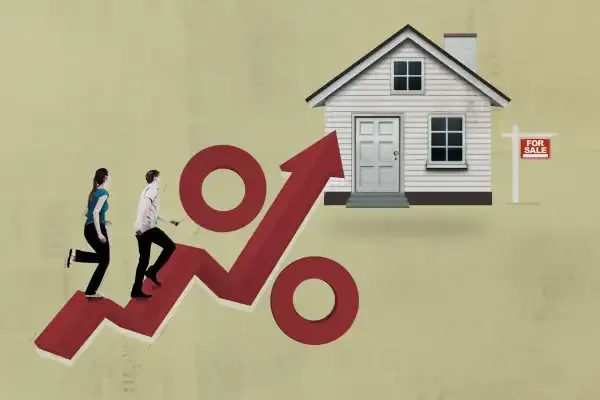Business
London Housing Market Slows as Average Mortgage Rates Stay Above Six Percent

Introduction
London’s housing market continued to cool in the final quarter of 2025 as elevated mortgage rates and sluggish wage growth weighed on buyer sentiment. The average two-year fixed mortgage rate remains above six percent for the third consecutive month, according to Bank of England data, while property transactions across the capital have fallen by nearly 12 percent compared with the same period last year. The slowdown reflects the broader economic adjustment following two years of aggressive monetary tightening and a persistent cost-of-living squeeze. Analysts expect the stagnation to continue into early 2026 as affordability challenges limit new demand and property developers delay new projects.
Market Overview
According to the latest figures from Halifax and the Office for National Statistics, average London house prices have slipped to £512,000, down 1.8 percent year-on-year. While price declines remain modest compared to the national average, the slowdown marks a sharp contrast to the rapid gains seen between 2020 and 2022 when ultra-low interest rates fueled demand. The Bank of England’s decision to maintain its base rate at 5.25 percent has provided limited relief to borrowers, as lenders remain cautious amid inflation risks and tighter wholesale funding conditions. The gap between average earnings and average mortgage payments continues to widen, with typical monthly repayments for first-time buyers now exceeding 45 percent of take-home income.
Data from HMRC shows that property sales volumes in Greater London have fallen to their lowest level since early 2020. Estate agents report fewer mortgage approvals and longer listing periods, with the average home now taking 56 days to sell, compared with 34 days a year ago. Higher financing costs have discouraged both buyers and investors, particularly in outer boroughs where price sensitivity is greater. Meanwhile, rental demand has surged as would-be buyers postpone purchases, pushing average London rents up by 8.1 percent year-on-year to a record £2,350 per month.
Policy Insight
The government faces renewed pressure to address the affordability crisis that continues to define the London property market. Despite several rounds of policy adjustments, including support for first-time buyers through limited deposit schemes, structural supply shortages persist. The number of completed new homes in London fell by nearly 14 percent over the past twelve months, according to data from the Department for Levelling Up, Housing and Communities. Developers cite higher borrowing costs, labor shortages, and planning delays as the main constraints.
The Treasury and the Department for Housing are expected to unveil a new urban development plan in early 2026 focused on streamlining planning approvals and incentivizing brownfield redevelopment. However, industry experts caution that these initiatives may take years to yield visible results. The Mayor’s office continues to advocate for greater devolved powers to manage local housing policy, including rent regulation and affordable housing targets tailored to London’s unique market dynamics.
Policy discussions are increasingly centered on how to balance fiscal prudence with support for housing supply. The government’s upcoming Autumn Statement is likely to include modest tax incentives for green building projects and infrastructure-linked housing zones. While such measures could improve long-term capacity, short-term relief for buyers remains limited. Analysts at the London School of Economics argue that the real solution requires a coordinated strategy between monetary, fiscal, and planning authorities.
City Response
London’s property sector is adjusting to a new equilibrium. Real estate firms report that buyers have become more selective, focusing on energy-efficient homes and stable neighborhoods with good transport links. Demand for smaller properties and shared ownership schemes has increased, reflecting the pressure on affordability. Developers have responded by scaling back luxury projects and shifting attention toward mid-market and rental developments.
Financial institutions in the City have also recalibrated their lending strategies. Major banks, including Barclays and Lloyds, have tightened credit assessments and reduced exposure to speculative developments. Meanwhile, fintech mortgage platforms continue to grow, offering digital-first approval systems that aim to streamline the application process. Analysts note that technology-driven competition could help improve transparency and efficiency in the mortgage market, though it may not offset the impact of high rates.
The slowdown has also affected related industries such as construction, furniture retail, and home improvement services. The Federation of Master Builders reports a decline in small project activity as homeowners delay renovations. Employment in the construction sector has fallen slightly, though demand remains strong for skilled labor in large-scale urban regeneration projects.
Market Impact
The stagnation of London’s housing market has broader implications for the UK economy. Housing activity is closely tied to consumer confidence and spending, and prolonged weakness could dampen household wealth effects. A slowdown in property transactions also affects stamp duty revenues and local government budgets, constraining fiscal flexibility.
Inflationary pressures have moderated but remain above target, partly driven by persistent shelter costs. The Consumer Prices Index including owner-occupiers’ housing costs (CPIH) rose 3.2 percent in September, with housing and utilities contributing the largest share. The Bank of England’s monetary stance reflects its concern that easing policy too soon could reignite inflationary momentum, particularly through the housing channel.
Financial markets view the current housing adjustment as a necessary correction following a decade of price expansion. Analysts at Bloomberg Economics note that London’s price-to-income ratio remains among the highest in Europe at over 12 times average earnings, underscoring structural affordability issues. As household balance sheets adjust, the market may transition toward slower but more sustainable growth over the medium term.
Outlook 2026
Looking ahead, economists expect London’s housing market to stabilize in the second half of 2026, assuming gradual declines in mortgage rates and modest income growth. The BoE projects that the policy rate could begin to ease by mid-2026 if inflation continues to fall toward the two percent target. This shift would lower borrowing costs and potentially revive buyer demand. However, structural challenges such as limited land availability, regulatory constraints, and demographic pressures will continue to influence market performance.
Foreign investment, once a major driver of London’s property boom, remains subdued amid global uncertainty and currency volatility. Yet, analysts expect renewed interest from institutional investors seeking exposure to long-term rental assets and sustainable housing portfolios. Green finance initiatives promoted by the City of London Corporation could also attract capital toward energy-efficient developments, aligning with the government’s net-zero objectives.
Conclusion
The London housing market in late 2025 reflects a delicate balance between monetary caution and economic adjustment. Elevated mortgage rates have effectively cooled demand, curbing price growth and reshaping buyer behavior. While this correction has improved market stability, it has also exposed deep-rooted affordability challenges that monetary policy alone cannot resolve. The outlook for 2026 hinges on a gradual easing of financial conditions and a more coordinated policy framework that addresses both demand and supply constraints. For households, stability may bring predictability but not yet accessibility. For policymakers, the priority remains ensuring that London’s housing market supports rather than constrains the city’s broader economic recovery.




















